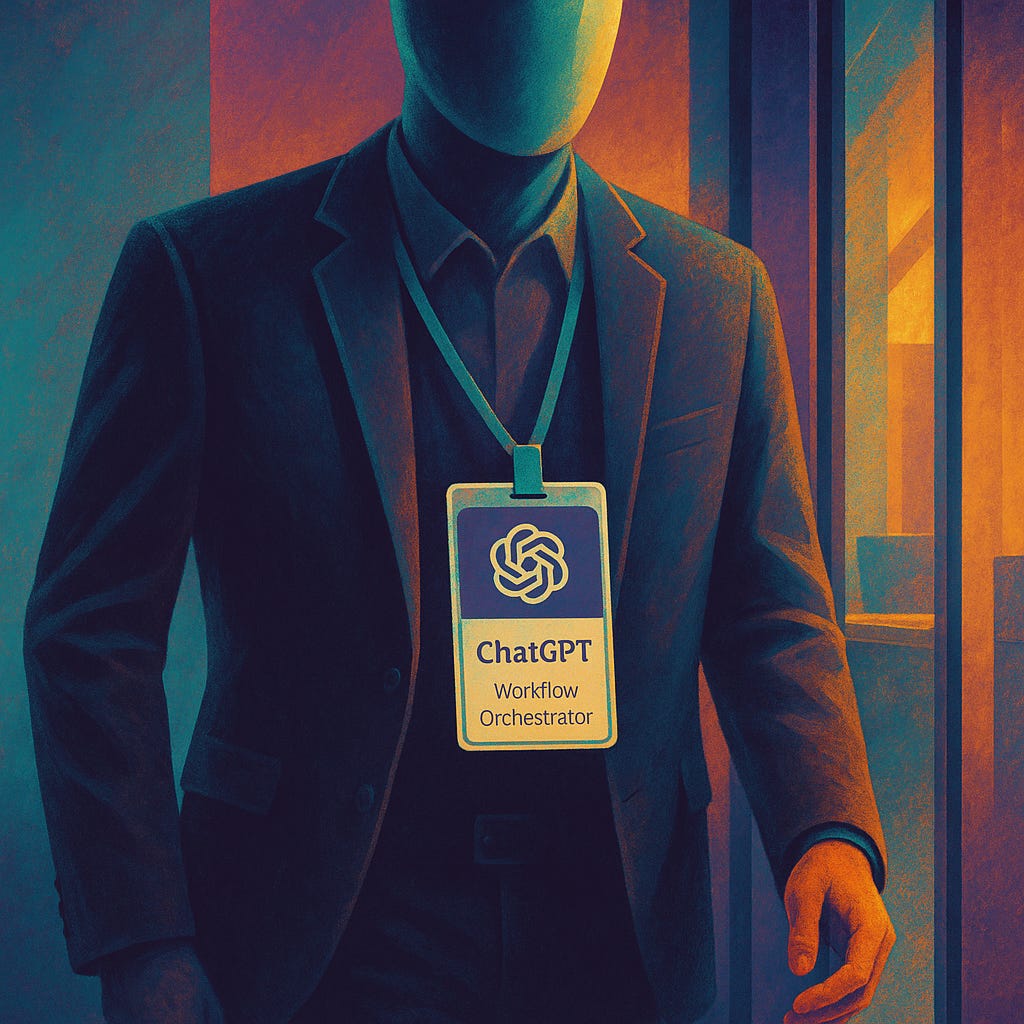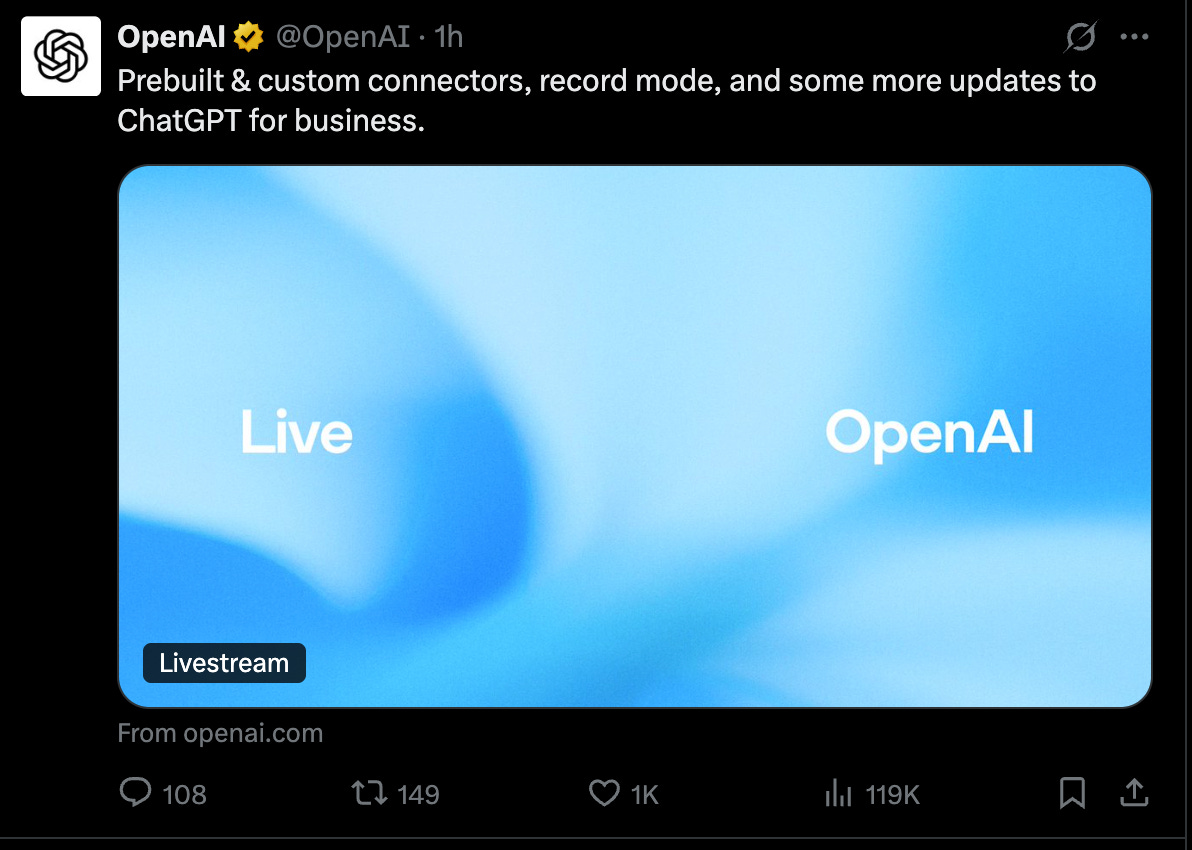OpenAI just clocked into the enterprise
Forget entering the chat - OpenAI is entering the workflow. The consumer AI leader wants to change how work gets done.
Dust off your “OpenAI killed my startup” t-shirts.
The company just put on its big boy pants and entered the enterprise - deliberately this time, not just by osmosis from consumer demand. The leader in consumer AI is making its intentions clear: it’s not just here to chat. It’s here to work.
Announced today:
📂 Connectors for Cloud Services: Integration with Google Drive, OneDrive, SharePoint, Dropbox, and Box - enabling ChatGPT to access and synthesize internal documents.
🎙️ Meeting Recording + Transcription: Automatic note-taking with timestamped citations, action item suggestions, and the ability to query transcripts.
📄 Canvas Integration: Action items from meetings can now become structured plans inside Canvas, OpenAI’s tool for collaborative writing and coding.
🔍 Deep Research Connectors: Plug-ins for HubSpot, Linear, and select Microsoft/Google tools that feed structured data into ChatGPT’s Deep Research mode.
⛓️ MCP (Model Context Protocol): Lets enterprises pipe in custom context from their proprietary tools to enhance ChatGPT’s research/report generation.
OpenAI now has 3 million paying business users, up from 2M just three months ago. That’s 1M net new in a quarter. They're signing 9 new enterprises a week. Companies like Lowe’s, Morgan Stanley, and Uber are customers.
The vision? Stop toggling tabs. Start treating ChatGPT as your workflow surface area, the orchestration layer across your files, meetings, systems, and decisions.
Why this is strategically important:
1. From universal knowledge to local intelligence
ChatGPT’s early power was breadth - its knowledge of the internet. But the real utility in the enterprise lies in contextual depth. These updates are about giving the model access to what the organization knows: internal docs, proprietary data, meeting histories. Context is the differentiator.
2. MCP isn’t just a connector protocol, it’s a wedge for verticalization
The Model Context Protocol, created by Anthropic and adopted by OpenAI, allows structured, real-time data to inform model outputs. This opens the door to domain-specific agents, not just general assistants. A legal agent that sees briefs. A biotech agent that sees lab data. A sales agent that sees pipeline movement. The model becomes a reasoning engine on your information, not just public text.
3. Workflow integration creates lock-in
OpenAI doesn’t need to build full replacements for tools like Notion or Zoom. Instead, it wraps around them - extracting context, summarizing outputs, suggesting next steps. Once critical workflows are routed through ChatGPT, the model becomes the system of engagement, even if it's not the system of record. Switching away means rebuilding connective tissue.
4. OpenAI is hedging platform dependencies
Though closely aligned with Microsoft, OpenAI is building integrations that make ChatGPT OS- and cloud-agnostic. The ability to read from both Microsoft and Google ecosystems signals an intent to be the neutral orchestrator across platforms - not just a Copilot inside Azure.
OpenAI COO Brad Lightcap describes the vision:
“It’s got to be able to do tasks for you, and to do that, it’s got to really have knowledge of everything going on around you and your work. It can’t be the intern locked in a closet. It’s got to be able to see what you see.”
This announcement marks another step in our relentless march toward agentic AI, systems that don’t just assist, but observe, reason, and act within real workflows.
The battle for the AI-first enterprise stack is officially on.
Model providers like OpenAI, Anthropic, and Google are moving up the stack - from infrastructure into interfaces, embedding themselves directly into workflows.
Productivity platforms like Notion, ClickUp, and Zoom are moving down the stack - integrating reasoning, summarization, and retrieval into existing workflows.
System incumbents like Microsoft and Google already straddle both layers -and are working to consolidate control through native integrations, identity, and distribution.
So while this launch pushes the vision of agentic AI forward, it surfaces a more strategic question: Can a model provider become the place where work happens - or just the thing that helps it along?





This is the scenario where I believe we're heading: Within the next 8-10 years, shifts in how AI is integrating with our lives will not be remarkable because they will have already become omnipresent. I will wake up one morning and decide I want to be something else in some way, smarter, funnier, faster, thinner, …whatever it is. After communicating that with my personal AI (we can call it Chad), it will develop a plan for me to achieve it, including a daily schedule with activities designed to improve my condition; licenses, memberships, and order forms pre-arranged to have access to those products and services detailed in my schedule; and integration of my new schedule with the schedules of household members, close friends and contacts, and business calendar meetings and events, so that reaching my new goal is executable and not in conflict with external commitments. Following my comment, Chad will quickly provide a summary and request approval to make permanent any immediate changes to routine, budget, business and relationship impacts, etc., but not in a verbose or overly calculated way; rather in simple terms, like “ok, we can do this with limited impact to your core areas of concern.” It’ll be something like that.